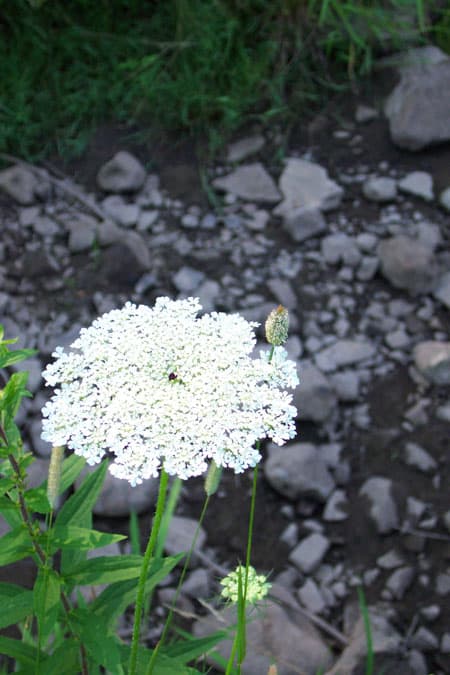How to Grow Queen Anne's Lace Wildflower

About Growing Queen Anne's Lace Wildflower or Garden Flower
Got an English cottage garden? Then, you are most likely growing Queen Anne’s Lace flowers in it. Not surprisingly, this flower originated in Europe. Queen Anne’s Lace plant gets its name for the lacy nature of the flower head. It was very popular during the reign of who other than……. Queen Anne. Also known as Wild Carrot, this wildflower is easy to grow, and is prolific in spreading its seeds by the wind. It can be found growing wild along roadsides and in fields almost anywhere in the U.S. The field in the picture above was farmed the prior year. Indeed, a field left fallow for just one year quickly becomes a field of Queen Anne’s Lace Wildflowers.
The plant is a biennial that normally grows three to four feet tall but can grow almost five feet in the right conditions. Its flowers are white and sometimes pink. Being related to the carrot, it has a carrot-like root that even smells like a carrot. Some suggest it is edible cooked, while others say no. This doubt exists because Poison Hemlock can be easily mistaken for Queen Anne’s Lace, due to their similarities.
Look closely at a Queen Anne’s Lace flower. You will see a tiny purplish-black floweret in the center of the otherwise white flower? The black floweret is sterile and will not produce seed. Biologists do not know why nature put it there. Perhaps it exists to attract pollinators.
One man’s flower is another man’s weed. Some flowers gardeners consider this an attractive flower. Others call it an invasive, or noxious weed. It readily displaces native wildflowers.
Other Names: Bishop’s Weed, Bishopsweed, Bullwort, Lady’s Lace, Wild Carrot
Flowers Bloom: Summer to early Fall.
Flower Colors: White with a single black floret in the center.
Ammi maju

Queen Anne's Lace Medicinal Uses
There are several medicinal uses, including:
- It is an antiseptic diuretic for the treatment of skin diseases, cystitis, and prostatitis.
- The seeds help to wash out urinary stones.
- Use the roots as antacids.
- And a poultice of roots relieves itchy skin.

How to Grow Queen Anne's Lace Flower Plants
Brought to the U.S. from Europe, Queen Anne’s Lace was originally used in old Victorian gardens. Its tiny seeds are easily spread by the wind, and they quickly spread around the landscape.
Did you Know? Queen Anne’s Lace is a member of the Parsley family.
Growing Queen Anne’s Lace is all too easy. All it takes to add them to your field is to spread a few seeds around. Next, year, you will have plenty. After planting them in year one, you will never have to plant them again. If you want some for a garden setting, spread the seeds in the location you have chosen. They require little attention.
This hardy wildflower thrives in poor soils and dry conditions. The plants grow best in full sun.
Insect and plant diseases do not appear to be too common. However, you may experience plant disease problems in wet, humid weather.
Ideal Soil pH: 5.5 – 7.0.
Plant Hardiness Zones: 3 -9
Also, see:
Plant Problems – Identify the causes and find the cures.
Related Articles
Also, people who read this article will like:
How to Grow Just about any Flower – We’ve got you covered with “How to Grow”‘ guides for all of your favorite flowers.
Please support our site. Shop for:
- rmmatthews100@hotmail.com
- 585-721-6528
- Rochester, NY
©1999-2024 GardenersNet.Com, All Rights Reserved

